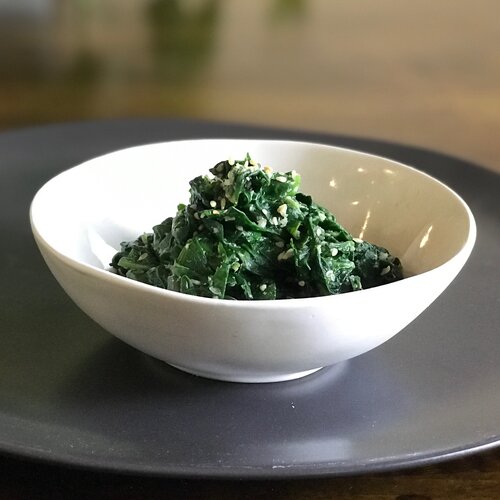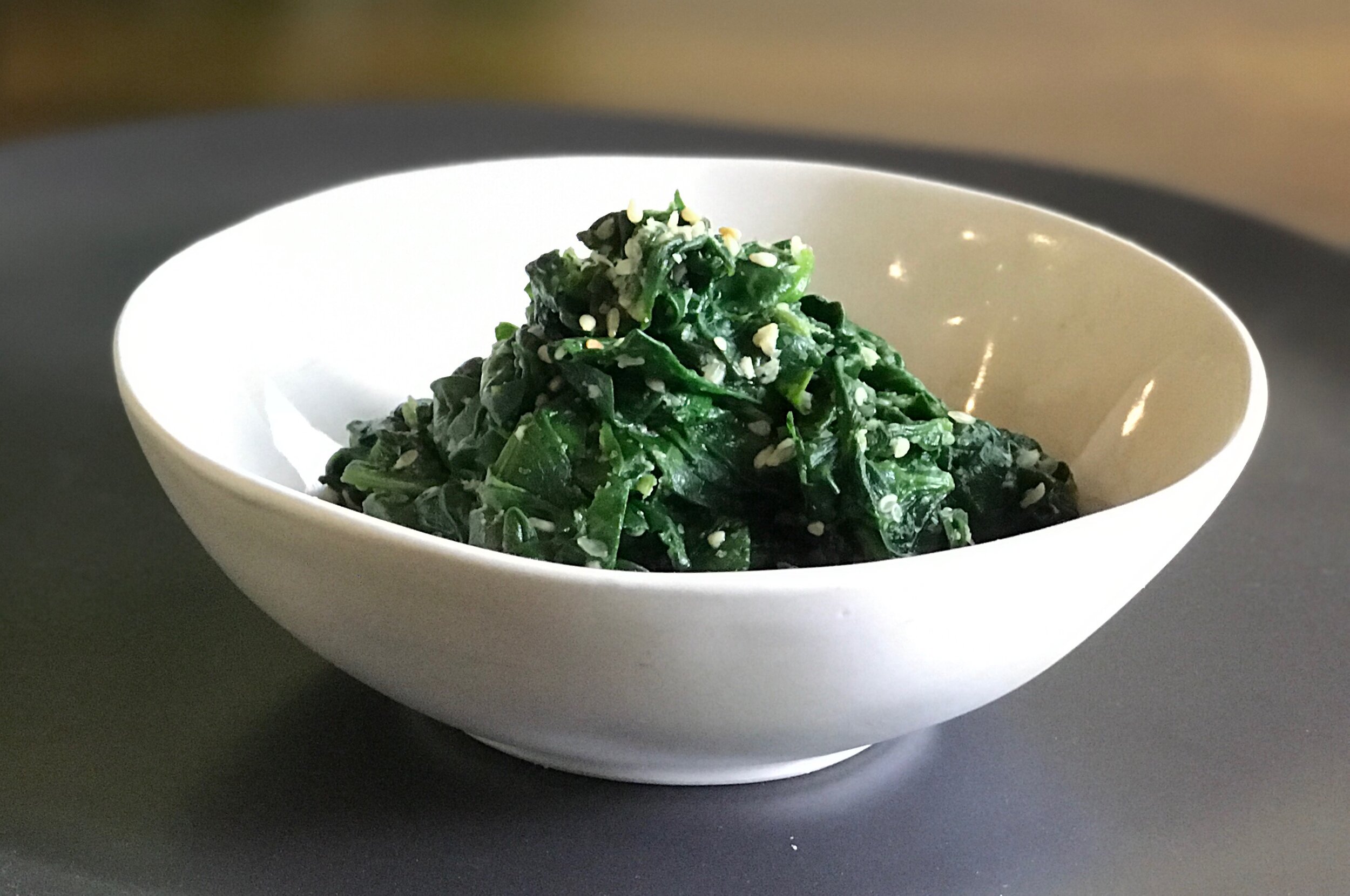Spinach with Sesame Dressing (Hōrensō no Goma-Ae)
Shizuo Tsuji writes in Japanese Cooking: A Simple Art, from which this recipe is adapted, that the first taste of the dressing is “like delicately roasted peanuts.” We love it with Koji-Marinated Salmon, Crispy-Skinned Southeast Asian Grilled Chicken Thighs or as part of a bento box.
For a vegan version of the dish, use a kombu dashi rather than a kombu-and-bonito dashi (see recipe notes below). For a gluten-free version, substitute gluten-free tamari for the soy sauce.
4 servings.
Ingredients
4 tablespoons white sesame seeds, plus 1 teaspoon for garnish, if desired
1 teaspoon sugar
2 teaspoons soy sauce
3 tablespoons dashi (see recipe notes below)
1 pound baby spinach
Instructions
1. Bring a large pot of salted water to a boil. Add the spinach and cook very briefly — just until it is limp and the color darkens. Drain and rinse under cold running water. Drain well and gently squeeze out the water from the cooked leaves. Set aside.
2. To make the dressing, toast the sesame seeds in a dry pan over medium heat, stirring frequently, until just golden. Transfer 4 tablespoons of them to a suribachi (Japanese grinding bowl) or a large mortar and crush with a pestle, reserving the rest for garnish. Add the sugar, and stir it in with the pestle. Add the soy sauce and dashi. Mix with relatively great speed and strength, almost a whipping action, to blend well. Taste and add more sugar, if you think it is necessary, mixing well again.
3. Add the spinach to the suribachi or mortar. With a very light touch, use the pestle or a spoon to mix the spinach and dressing. The spinach should be very slightly bruised to allow the sesame dressing to penetrate. Do not crush.
4. To serve: Divide the spinach into four small, deep dishes. Sprinkle with the reserved sesame seeds (if using) and serve at room temperature.

Spinach with Sesame Dressing (Hōrensō no Goma-Ae)
Ingredients
- 4 tablespoons white sesame seeds, plus 1 teaspoon for garnish, if desired
- 1 teaspoon sugar
- 2 teaspoons soy sauce
- 3 tablespoons dashi (see recipe notes below)
- 1 pound baby spinach
Instructions
- Bring a large pot of salted water to a boil. Add the spinach and cook very briefly — just until it is limp and the color darkens. Drain and rinse under cold running water. Drain well and gently squeeze out the water from the cooked leaves. Set aside.
- To make the dressing, toast the sesame seeds in a dry pan over medium heat, stirring frequently, until just golden. Transfer 4 tablespoons of them to a suribachi (Japanese grinding bowl) or a large mortar and crush with a pestle, reserving the rest for garnish. Add the sugar, and stir it in with the pestle. Add the soy sauce and dashi. Mix with relatively great speed and strength, almost a whipping action, to blend well. Taste and add more sugar, if you think it is necessary, mixing well again.
- Add the spinach to the suribachi or mortar. With a very light touch, use the pestle or a spoon to mix the spinach and dressing. The spinach should be very slightly bruised to allow the sesame dressing to penetrate. Do not crush.
- To serve: Divide the spinach into four small, deep dishes. Sprinkle with the reserved sesame seeds (if using) and serve at room temperature.
Notes
RECIPE NOTESTsuji’s original recipe, which calls for “fresh spinach” rather than “baby spinach,” assumes you are using Japanese spinach, which has leaves that are “smaller, more delicate, spear-shaped and not deeply crinkled” in comparison to American spinach. Baby spinach works well in its place.Primary or secondary dashi may be used for this recipe. If you do not have dashi on hand and you have kombu but not bonito flakes, you can make a kombu dashi by soaking a piece of kombu (about 4 inches square) in 4 cups of filtered water for 3 to 10 hours at room temperature. Alternatively, you can make instant dashi by dissolving 1/2 teaspoon HonDashi in 1/2 cup boiling water. Substituting chicken broth would probably work fine as well.Tsuji’s recipe did not suggest a sesame seed garnish; we added that as that’s how we have enjoyed the dish in many Japanese restaurants.
Recipe notes
Tsuji’s original recipe, which calls for “fresh spinach” rather than “baby spinach,” assumes you are using Japanese spinach, which has leaves that are “smaller, more delicate, spear-shaped and not deeply crinkled” in comparison to American spinach. Baby spinach works well in its place.
Primary or secondary dashi may be used for this recipe. If you do not have dashi on hand and you have kombu but not bonito flakes, you can make a kombu dashi by soaking a piece of kombu (about 4 inches square) in 4 cups of filtered water for 3 to 10 hours at room temperature. Alternatively, you can make instant dashi by dissolving 1/2 teaspoon HonDashi in 1/2 cup boiling water. Substituting chicken broth would probably work fine as well.
Tsuji’s recipe did not suggest a sesame seed garnish; we added that as that’s how we have enjoyed the dish in many Japanese restaurants.


